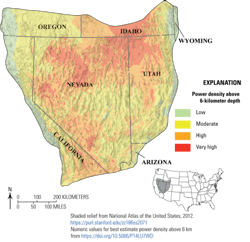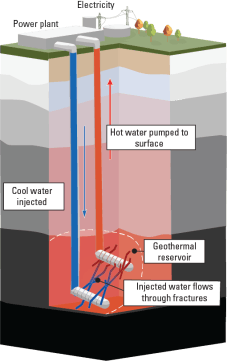Enhanced Geothermal Systems in the Great Basin Have Potential to Contribute to U.S. Electricity Supply
A new assessment from the U.S. Geological Survey (USGS) indicates that geothermal energy resources in the Great Basin region — spanning Nevada and parts of California, Oregon, Idaho, Wyoming, and Utah — have the potential to generate an amount of electricity comparable to approximately 10% of current U.S. power consumption.
This estimate significantly exceeds the current contribution of geothermal energy, which accounts for less than 1% of national electricity production. The updated assessment builds on a 2008 USGS evaluation and incorporates advancements in geothermal and related technologies developed over recent decades.
The findings rely on the assumption of widespread commercial-scale development and successful implementation of enhanced geothermal systems (EGS). EGS involves engineering techniques that enable water to circulate through deep, impermeable rock formations — typically located up to 6 kilometers (3.7 miles) below the surface — to extract heat for electricity generation.
“USGS assessments focus on future resource potential,” said Sarah Ryker, acting director of the USGS. “This study was conducted in the Great Basin due to its history of geothermal activity. The results indicate more potential for continuous power generation than previously recognized. Integrating new methods, including artificial intelligence and machine learning, will support broader geothermal assessments across the country.”
Unlike traditional hydrothermal systems, which rely on natural groundwater flow through heated rock, enhanced geothermal systems target regions where heat is available but fluid flow must be artificially enabled. These systems expand the range of geothermal development beyond naturally occurring reservoirs.
The Great Basin has a long history of geological exploration. It was among the last areas of the contiguous United States to be systematically mapped in the 19th century. Early surveys by Clarence King and John Wesley Powell helped lay the foundation for the establishment of the USGS in 1879.
“Resource mapping continues to evolve, enabling identification of geothermal potential, critical minerals, and groundwater,” Ryker said.
The USGS conducted the new assessment in response to a mandate under the Energy Act of 2020, which called for a nationwide evaluation of geothermal resources. The study incorporated updated heat flow and subsurface temperature maps, as well as new models for estimating the efficiency of converting subsurface heat into usable electricity. The Williston Basin in North Dakota is identified as the next region scheduled for assessment.
“The updated map of enhanced geothermal resources reflects collaborative work by USGS, the Department of Energy, universities, and state geological surveys,” said Erick Burns, the report’s lead author. “These estimates incorporate early technological achievements in the field.”
According to the assessment, realizing the full potential of geothermal resources in the Great Basin will require continued innovation in engineering and energy extraction techniques. While significant heat exists underground, technological improvements are necessary to efficiently convert this resource into electricity at scale.

